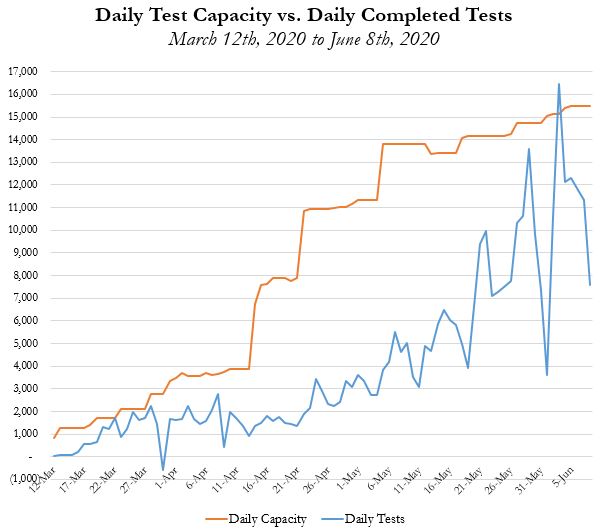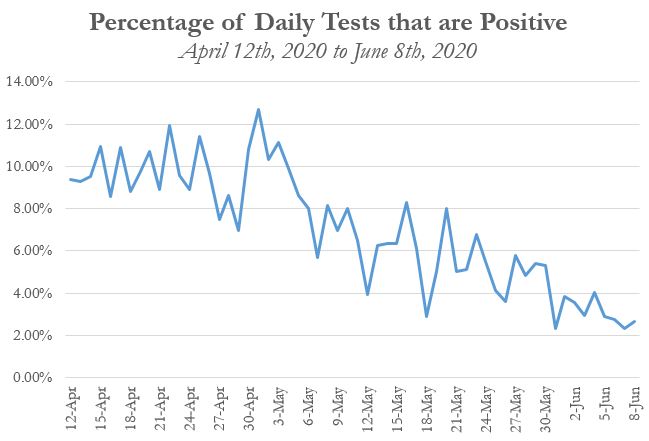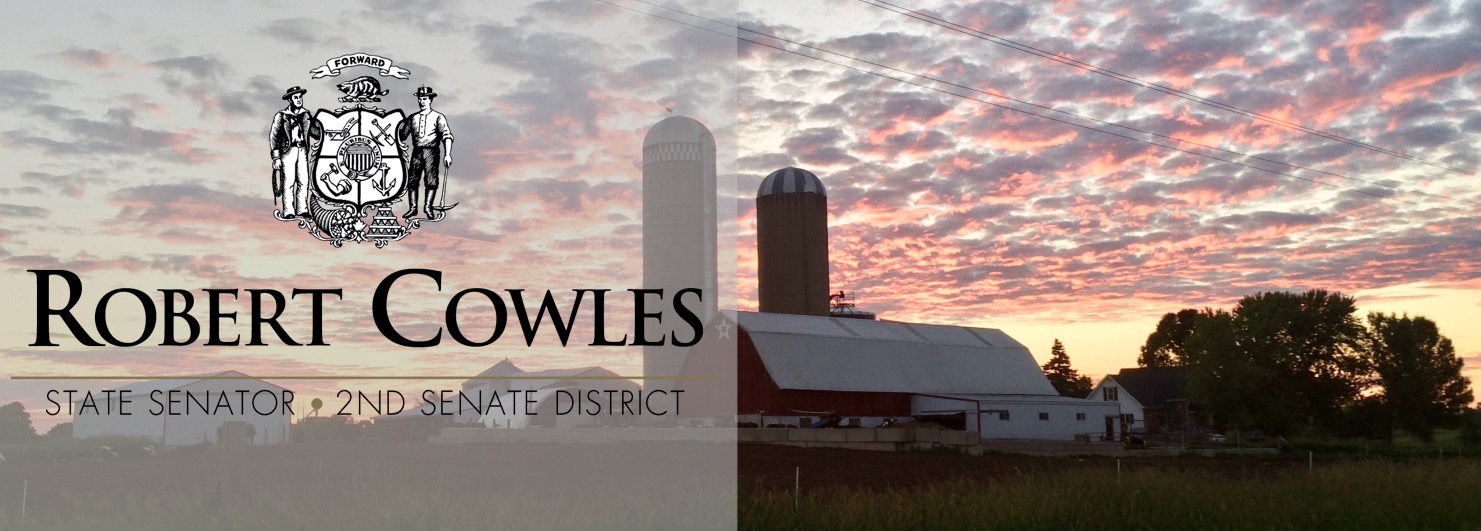|
Dear Friends and Neighbors,
Over the past few months, Iíve used this email list to
do my best to keep you informed, while trying to not
overwhelm you, about the status of the COVID-19 outbreak
and the stateís response to these unusual times. Iíve
heard from some of you about how this information has
helped you in your daily lives, whether that was through
online resources to help children adjust to school
cancellations, links to different resources to assist
with the economic hardship faced by businesses and
farms, or simply by providing information when that
isnít always easy to find.
In accordance with state law during an election year,
today is my last day that I am able to distribute any
pieces of information in quantities of fifty or more.
Given this limitation applies both digitally and in
print, this will be my last e-newsletter of the year. I
will continue to provide the latest information
available on my
Facebook and
Twitter pages, so please consider following me
there. I wish everyone the best as we enter the summer
months, and I hope that you all have the opportunity to
enjoy the nice weather while it lasts.
Congratulations to High School Graduates
Itís that time of year where young adults throughout
Northeast Wisconsin will celebrate the end of their K-12
career, and unfortunately they meet this culminating
point as they enter an uncertain world. While I normally
have the pleasure of attending a number of
commencements, a lot has changed this year as in-person
ceremonies have been either delayed or cancelled.
Even though the ceremonies are different for 2020, the
achievement is still the same. So for the hundreds of
graduates in the 2nd Senate District,
CONGRATULATIONS,
and I canít wait to see what you do next!
Local Companies Are Hiring
Recent economic projections have both given cause for
hope and cause for concern. Anecdotally, Iíve heard
numerous stories from the 2nd Senate District about
residents returning to work and feeling safe doing so
thanks to the precautions put in place by management and
co-workers. Unfortunately, not everyone is back to work,
and others may be looking for a change of pace after the
past couple of months.
If you find yourself looking for short-term employment
or a long-term career, hundreds of opportunities
currently exist in and around the 2nd Senate District.
With listings in banking, retail, healthcare,
manufacturing, nonprofits, childcare, auto repair, and
more, youíre bound to find something that interests you.
A number of websites exist to help connect you to your
next chapter, including the:
Overview of Personal Protective Equipment
One of the most important aspects of the medical care
communityís response to COVID-19 has been personal
protective equipment, abbreviated as PPE. While working
with patients that have or may have COVID-19, given that
thereís no vaccine, PPE is the only line of defense
protecting doctors, nurses, and first responders from
catching the virus themselves. Not only would infections
potentially impact their long-term health and wellbeing,
but also, even without major health impacts, this
critical workforce would be depleted.
But PPE hasnít only been for healthcare workers, as
weíve seen the use of masks surge among the public and
in workplaces, and weíve also witnessed some residents
choose to use other PPE such as gloves while in stores
or out in other public places. Thereís no question that
PPE has been a major topic of discussion lately and has
made its way into many of our daily lives. Thatís why I
wanted to take a moment to give an overview of PPE in
Wisconsin and to try and answer some questions Iíve
heard from constituents and some that Iíve had myself.
There are generally five main types of PPE that are
categorized into this broader term when referring to
COVID-19, including face shields, goggles, N95 masks,
gowns, and paper or surgical masks. Obviously, other
types of PPE exist, including gloves and shoe covers,
among other things, but these items arenít commonly
tracked as theyíre more common in a medical practice for
all conditions, where the five specifically tied to
COVID-19 are less frequently utilized in a typical
healthcare setting.
Shortages of PPE were a key issue near the beginning of
the outbreak in Wisconsin. At times, half of the stateís
133 hospitals had a seven day or less supply of any of
the five key types of PPE. That led to several efforts
on a state level, with local and federal partners, to
help alleviate the backlog.
First, according to the most recent data which goes
through May 8th, the Strategic National Stockpile has
provided, at the stateís request:
-
202,800 eye and face shields;
-
1,022,400 N95 masks;
-
4,479,400 gowns, and;
-
8,025,600 surgical masks.
The state also set up a website for donations of PPE and
medical supplies. While certain donations were
publicized on the Department of Military Affairsí
communication channels, including one from Thrivent in
Appleton, the total amount of PPE received through this
website is unknown.
Receiving the supplies is only the first step, as moving
from a federal warehouse to a state warehouse isnít must
of an improvement. With the help of dozens of National
Guard members, both on land and air, the supplies were
often distributed within days of being received to
healthcare providers and local governments throughout
the state. The dissemination was guided by provider
requests through a website run by the State Emergency
Operations Center.
In addition to their PPE distribution duties, the
National Guard has also been involved in assisting with
the collection of used N95 masks and taking them to
decontamination facilities where they can be cleaned and
safely reused up to twenty times. This procedure reduces
waste and helps to alleviate shortages of supplies.
While these efforts by the state undoubtedly made an
impact, they must also be measured with the impact made
by local companies and good samaritans during the
outbreak. Iíve shared nearly a dozen stories in previous
e-newsletters about individuals making masks for
long-term care facilities and individuals, and some
companies switching production lines to create or
decontaminate PPE.
I wanted to share one more example. Novolex in Shawano
didnít just sit back during the COVID-19 outbreak, they
stepped up to see how they could help. The plant is now
producing well over a million medical-use gowns each
month to help protect workers on the front-lines caring
for patients. Some of these gowns have been used
locally, while others are being distributed around the
nation by the Department of Defense for facilities most
in-need. Novolex is also taking strong steps to ensure
the safety of their employees. Currently, they have 105
employees in Shawano, and they are looking to hire more.
Thanks to Novolex for all that they do in Shawano and
around the country! Read more about their efforts on the
Shawano Leaderís website.
With the public and private efforts made over the past
few months, the shortage of PPE in hospitals has nearly
been eliminated. In the two regions covering the 2nd
Senate District data made available by the
Wisconsin
Hospital Association shows that of the 23 hospitals
in the 15 counties, only 1 hospital reports a seven day
or less supply of face shields, googles, and surgical
masks. There are also 2 hospitals that report a shortage
of N95 masks and gowns.
While the goal is for no hospitals to experience these
shortages, the numbers now indicate a substantial
improvement from the situation we were facing even just
a few weeks ago. Looking ahead, the state will continue
to provide assistance to healthcare providers, first
responders, and communities to fully alleviate supply
shortages. As I noted in last weekís e-newsletter, among
the investments from the federal Coronavirus Relief
Fund, $150 million will be spent to acquire and
distribute PPE throughout the state.
Committing to assist with PPE acquisition and
distribution typically isnít the stateís role, but when
demand surges, the collection and purchasing power of
the state is greater than that of many providers,
particularly rural providers. As I started by saying,
PPE is the last line of defense to protect the
healthcare workers and first responders that put their
lives on the line to help us. Ensuring theyíre properly
outfitted and ready to combat this virus as it emerges
in patients is the least we can do.
Details on New Farm Assistance Now Available
Even before the outbreak of COVID-19, many farmers
throughout our state had already been dealing with tight
revenue margins and shrinking markets. The pandemic only
worsened the circumstances for many agricultural
producers in Northeast Wisconsin as they start the
growing season with sizable financial outputs and
declining revenues.
In last weekís overview of the Coronavirus Relief Fund
spending plan, I briefly gave the minimal details we
knew about the $50 million allocated for farm
assistance. Fortunately, after an announcement last
Friday, Iím pleased that we have more information that I
can pass along about this important program for some
Northeast Wisconsin residents.
In the Wisconsin Farm Support Program, farmers may be
eligible for a direct payment between $1,000 and $3,500.
Eligible farmers must have a 2019 gross income between
$35,000 and $5,000,000, among other eligibility criteria
listed online. Applications open next Monday, June 15th,
and run through June 29th. Interested parties can learn
more about eligibility and apply at the
Wisconsin Department of Revenueís website. Farmers
with limited internet access can also apply by calling
(608) 266-2772.
The economic toll from COVID-19 is tough, but Wisconsin
is tougher. This crisis wasnít a making of farmersí own
fruition, but instead a once-in-a-generation pandemic
thatís had widespread impacts. This program isnít
perfect, and thereís no guarantee that everyone who
applies will receive assistance, nor can the payments
fully cover the lost opportunities and continued
expenses. But every little bit helps. I strongly
encourage any farmer who may quality and whoís felt
impacts from the Coronavirus to consider these options
and not let these programs pass them by
Progress Being Made on COVID-19 Testing
A little over a month ago, I provided an overview on the
status of COVID-19 testing in Wisconsin and the
roadblocks that the state faced in ramping-up testing
efforts. If you want to review that information, please
check-out the May 4th edition of the
Updates from the State Senate e-newsletter.
Things can change quickly, though, and Iím happy to
report that when it comes to testing, Wisconsin has
changed for the better. Robust testing efforts are
crucial for one primary reason: finding more cases of
COVID-19 allows the provider to ask for those patients
to isolate sooner, reducing the risk of spread and
helping to control and minimize the outbreak. With this
in mind, I wanted to provide a quick update on the
status of COVID-19 testing.
As of this Monday, June 8th, 354,291 tests for COVID-19
have been completed in Wisconsin. If you presume only
one tests was administered per person, the number of
tests would represent 6.1% of our stateís population. Of
those tests, 21,038 have been positive for COVID-19, or
5.9% of total tests completed. Thanks to the expansion
of public-private partnerships, Wisconsinís lab testing
capacity has continued to grow, now exceeding the
capability to process over 15,500 tests per day by more
than 50 labs.
However, this creates a distinction that Iíd like to
reiterate: capacity is not testing. The number of tests
completed is not always near the amount of tests that
the state believes could be processed. However, since
the last update, the state has taken numerous steps to
both increase daily testing and maintain a high capacity
to run tests. The chart below shows Wisconsinís capacity
for testing versus the number of tests that have been
completed daily since the Public Health Emergency began.

As you can see, thereís been a wide degree of
variability in the number of daily tests completed over
the past two weeks, as daily reported tests have ranged
anywhere from about 3,600 to 16,500. However, if you
look at the daily average in the fourteen-day period
from May 26th to June 8th, 10,381 tests have been
completed on a daily basis. Thatís quite an improvement
from my last e-newsletter where I reported an average of
2,686 daily tests over a two-week period.
The number of tests certainly isnít the only important
metric. While more tests may lead to more positive
results, state and federal health officials generally
look towards the percentage positive metric to determine
progress on controlling the outbreak. This statistic is
created by taking the total positive tests on a daily
basis divided by the total tests completed. Over the
past two weeks, the daily percentage positive has
averaged 3.73%, as seen in the chart below. That
compares to the average from the last e-newsletter which
was 9.88%. Again, a remarkable improvement.

As you can see, tests are much more available than they
once were, and with a state investment from the
Coronavirus Relief Fund of $260 million in testing,
options should remain robust for as long as demand
exists. If youíre looking to receive a COVID-19 test,
options exist near you at no cost. Learn more about
drive-through testing options on the
Department of Health Servicesí (DHS) website, or
contact your local provider for a more convenient option
if necessary. Additionally, for testing numbers on both
a statewide basis and on a county level updated around
2pm daily, please visit
DHSís website.
Even as weíve seen testing increase and as weíve been
finding new cases, hospitalizations have continued to
drop. Around the time that the last e-newsletter on
testing was sent, in our area, around 70 to 80 or more
cases resulted in hospitalization at any given time.
Now, weíre down to about two dozen cases as of today.
Hospitalizations are also a lagging indicator, as
testing can be done upon symptoms emerging where
hospitalizations come days, sometimes weeks after the
diagnosis may be confirmed.
Finally, I wanted to briefly mention antibody testing as
the other testing option thatís been discussed in the
media. Unlike acute diagnostic testing options which
were discussed above that actually diagnose or determine
if you have COVID-19, antibody, or serology testing can
determine if youíve had but recovered from the virus.
Questions about the accuracy of any given antibody test
have been raised, with some estimates as high as 50%
failure rates. Thatís why some providers that conduct
antibody tests have chosen to group tests together from
one person, as more tests can give more certainty when a
result is provided.
While antibody testing hasnít emerged as a widespread
effort, public health officials do note that it can have
merit in determining the extent of potential Ďherd
immunityí, or the percentage of the population that have
a reduced risk of reinfection. As an alternative to
antibody testing, health officials have discussed
potentially sampling wastewater at a treatment plant to
determine the extent of the antibodies in waste.
Another example of why antibody testing has merit is for
determining potential plasma donors. Plasma with
antibodies has shown some promise as a treatment for
patients COVID-19, leading some, including the Community
Blood Center in Appleton to conduct antibody testing in
potential plasma donors. By identifying those whoíve had
or may have had COVID-19 and confirming that they have
the right antibodies, the Community Blood Center can
prepare a supply of plasma that can be used to help
future patients battling COVID-19. Learn more about this
effort on the
Community Blood Centerís website.
Work to Continue on the Audit Committee
As a result of Congressional actions over the past few
months, Wisconsin has been the recipient of over $3
billion in federal funding, and more funding may be on
its way. With this funding comes a lot of opportunities,
such as those Iíve outlined in the last e-newsletterís
Coronavirus Relief Fund section as an example. This
funding can help people and local institutions, such as
small businesses, nursing homes, and nonprofits, in
their time of need.
But with these opportunities also comes the risk of
waste, fraud, abuse, mismanagement, and a lack of
transparency. As Co-Chair of the Joint Legislative Audit
Committee, Iíve had the pleasure of working to serve as
an advocate for taxpayers over the past few sessions by
helping to create a more efficient state government.
In my role, I work closely with the award-winning
experts at the nonpartisan Legislative Audit Bureau to
monitor the administration of state programs and
allocation of state and federal funding year-round, but
in these unusual times, the oversight has now shifted
into overdrive.
Typically, the work of the Audit Committee is often
finding past faults in ongoing programs. By evaluating
several years of operations and data, the Audit Bureau
can make recommendations for the agency and the
Committee to act, sometimes legislatively and other
times through less formal continued follow-up.
However, with the unique nature of these new programs
designed to react to Coronavirus, this typical approach
wonít be the most effective given that these new
programs wonít be around for long. Thatís not to say
that thereís not merit behind an analysis once the
programs close-out as there are still lessons we can
learn from these audits for general administrative
improvements, but it is to say that a more proactive
approach is needed.
In close consultation with myself and my Co-Chair,
Representative Samantha Kerkman (R-Salem), the Audit
Bureau has already had dozens of conversations and
meetings with key officials in several state agencies,
and has examined hundreds of pages of documents from
these agencies. One example is the Department of
Workforce Developmentís Unemployment Insurance program,
where theyíve been actively working alongside agency
staff to determine whatís gone wrong in the agency and
why some claims take weeks or even months to process and
pay.
In another example, weíve already seen the Department of
Children and Families propose an administrative budget
of about $2.5 million for a childcare provider grant
program of about $50 million. Thankfully, careful work
by the Joint Finance Committee reduced that
administrative portion of the budget, in consultation
with the agency, to about $0.5 million, creating more
opportunities to provide assistance to childcare
providers with less paper pushing costs. While this
potential example of waste was caught, most new programs
have not required legislative review. As a result, we
donít know what administrative expenses have been
tallied to this point, but I intend on finding out.
From the audit work on Unemployment Insurance along with
the work in other agencies, the information collected
and evaluations made have not been finalized and are not
public yet. Over the summer, into early next year and
beyond, I look forward to continuing to discuss audit
findings and working to ensure accountability over every
program. I hope youíll follow along with the COVID-19
audit findings as they become available and I share them
on my social media pages.
Success of the Work-Share Program
Just yesterday, we learned about a success story that
has helped to save jobs made possible due to the
Legislatureís response to the Coronavirus outbreak: Act
185. Under this law, we expanded the Work-Share Program
from only applying to businesses impacting twenty or
more workers in one division to any employer with at
least two employees.
This program allows employers to reduce hours evenly
among employees and up to 60% of weekly hours when the
business is facing difficult times, with the lost hours
covered by Unemployment Insurance. Work-Share helps the
workers by keeping their pay up even with less hours. In
addition, work-share maintains the ability for employees
to retain benefits such as insurance. It also helps the
employers by allowing them to continue operations, even
at a reduced capacity, while maintaining their
connections to their valued employees instead of forcing
them into the job market.
Prior to the Coronavirus, Wisconsin had used just 20
Work-Share plans which involved about 900 participants.
The Department of Workforce Development announced
Tuesday that there are now more than 500 Work-Share
plans with almost 18,000 worker participants. While a
reduction in hours is never welcome news, the success of
the Work-Share Program has helped to substantially
lessen the blow for over 500 businesses and 18,000
Wisconsinites during these difficult times.
Until Next Time
While this will be the last e-newsletter for a while, my
staff and I will remain available throughout the summer
and into fall to assist with any questions or concerns
you may have involving state government.
Please feel free to
contact my office with any questions or concerns you
may have, and be sure to connect with me on
Facebook,
Twitter, and
Instagram for regular updates on Coronavirus and
more from around the 2nd Senate District and in the
State Capitol.
Thanks for reading!

Senator Robert Cowles
Proudly Serving Wisconsin's 2nd Senate District
|

